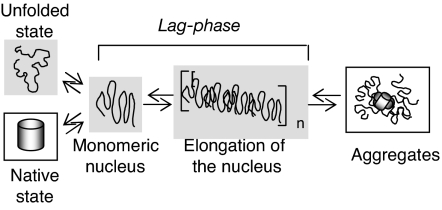Fig. 5.
A schematic model of proline action on various species in the aggregation pathway. The disfavored species are shown with shadowing, and favored species are indicated by boxes. The solvophobic properties of proline disfavor species with greater solvent-exposed surface area, e.g., partially folded (nucleus) and unfolded ensembles. At early stages, intramolecular interactions are favored by the addition of proline, leading to a relative stabilization of the native state. In the later phases, intermolecular interactions are favored, promoting the formation of aggregated species that effectively sequester solvent-accessible surface area.

